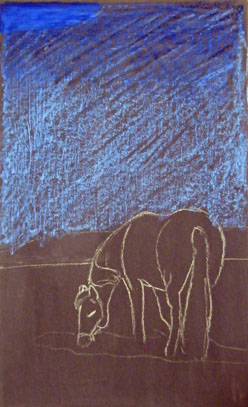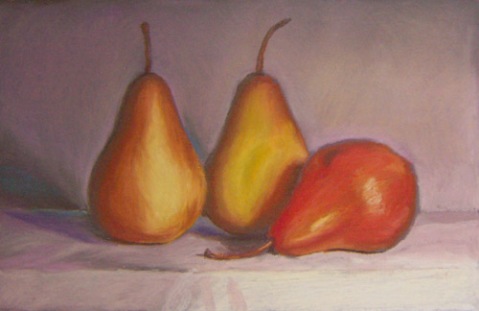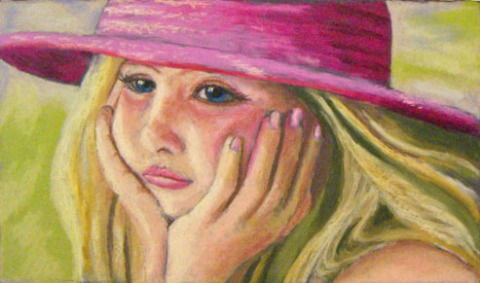How to draw and paint with oil pastels – FAQ
June 28, 2008 § 6 Comments
There are quite a few reasons why I like oil pastels (OPs). Here are a few of them:
- bold colors (see the little sketch above, left: colored pencil, middle: oil pastel, right: pastel crayon)
- they are easy to apply and easy to use (no cleaning of brushes, no dangerous solvents, etc.)
- they don’t dry too fast, there is no need to hurry (vs. acrylic paint)
- you can paint dark over light and light over dark
- you can carry them anywhere
Although OPs are no new medium, they aren’t as common and wide spread as other drawing and painting mediums, so that’s why I’m doing this little FAQ consisting of questions I have been asked often.
Q: I’ve recently bought myself a little set of oil pastels and would like to paint with them, however, I have a very hard time trying to blend them. Why?
A: Most probably you got yourself the wrong kind of oil pastels. There are basically two kinds of OPs: artist grade (which can be blended) and student grade (which cannot really be blended well). There are only a few artist grade brands that are really recommendable if you want to paint with oil pastels:
- Sennelier oil pastels
- Hohlbein artist grade oil pastels
- Caran d’Ache “neopastel”
- Cray-Pas “specialists” (be careful, don’t confound them with the “expressionists” – the latter being student grade!)
- Erengi (a new brand, haven’t tried them yet, just mention them here to have this list complete)
All the other oil pastels are to be considered student grade, even if they claim to be “artists oil pastels”.
Q: What is the difference between artist grade and student grade oil pastels?
A: Actually I could give you a lot of answers on this one, but let me give you this comparison instead: if you are drawing with an artist grade OP it feels as if you were drawing with a lipstick whereas a student grade oil pastels feels more like a wax crayon.
Q: Unfortunately, it seems I’ve bought a student grade oil pastel set, is there no way to make them work? I’ve read somewhere that OPs can be solved with turps?
A: Yes, you can solve them with turps – to a certain degree. However, I doubt that the results will look smooth or nice, more likely you’ll end up ruining your painting surface. The best advice I can give you is save yourself an unnecessary expense and frustrating painting results by getting proper pastels from the very beginning. It’s true that artist grade oil pastels are so much more expensive, but you don’t need to buy a whole set at once. It’s a good idea to try to buy some colors from each brand so that you can try all of them out and see which brand you like best :).
Q: What tools do I need besides the oil pastels?
A: It’s alwayd advisable to get yourself a tool for spreading and blending the oil pastels. You might either get some Colour Shaper ™ or Clay Shaper ™ or you might as well take a firm eraser and shape him into the kind of form you prefer.
Q: What kind of support is advisable for oil pastels?
A: You can take almost any support you like. Most artists I know prefer Colorfix ™ papers or supports that have been primed with pastel primers. I for example like to paint on small pieces of framing mattes that I have primed before with pastel-ground. You could also take canvas or any kind of sturdy paper/board. Look for a surface that has a little bit of tooth.
Q: Do I need to seal my finished paintings with something? They feel so wet/sticky even days after, when are they going to be dry?
A: It is said that oil pastels never dry, however, those artist who work with this medium have found out, that the surface of an oil pastel painting will feel dry after a few months (which means it will be touch dry on the surface). You do not need to seal or fix your painting with anything, however, you might consider framing it behind glass for an optimal protection.
For more information on oil pastels, please visit: wetcanvas – getting started in oil pastels
Chiaroscuro terrier – or a pet that peeves
March 21, 2008 § 6 Comments

“chiaroscuro terrier”, mixed media, sketchbook
A pet peeve of mine are pets that peeve, especially those life models that would not stand still for only a second to let me capture at least one decent photo of them – not to talk about trying to sketch them! Just like this little gal here. I tried to photograph her several times, but all the shots got blurry.
Oil pastel painting WIP start to finish
March 16, 2008 § 5 Comments
Today is a big day – it’s my blog’s 1st birthday. Yet instead of a piece of cake I will offer you a tiny oil pastel tutorial. Enjoy!
The painting shown here was done for the February 2008 Oil Pastel Challenge on WetCanvas. Thank you very much Angela for this beautiful shot!

The first thing I need to know before starting a painting is the composition. In this case I decided to put this little horse into a nightly landscape and in order to show more of the night sky I decided to work on a vertical format.
I know that there are plenty of artists out there who can start painting right away and will always get a gorgeous result, but I need to have made up my mind completely before I can start to paint. I need to see the finished piece clearly in front of my inner eyes.
The photo above shows you how I usually start the paintings: I transfer the most important lines using either charcoal or white chalk, depending on the color of my support. No details for me at this stage.
.
.

Next step is choosing the right colors for this painting. I’ve made a color chart for that purpose, since one cannot always tell the color from looking at the pastel itself.
There’s really no need to choose the same colors as in your ref picture, just make sure, that you choose corresponding values and that the colors you choose match well together. Most of my paintings have stong complementary contrasts, but not all of them. This one here is almost monochromatic as one usually does not perceive colors by night (without artificial lighting).
.

That’s what I came up with. Basically 3 colors: pale yellows, light pinks and two blues. The olive green is just meant for adding some darker accents where necessary.
.

Next step is blocking in the main colors of the background. I always start with the background that makes it so much easier to find the right color and value for the main subject. And as you will notice, too, when looking at the upper left corner I also start blending the OPs almost immediately as I like a smooth and even surface, almost like an oil painting.

That’s what the painting looks like after having blended all the colors in the background. Now I can start working on the horse. I decided to leave the dark color of the background as the darkest value on the horse and just added lighter colors where necessary and this was the result:


WeCa: Three Pears
March 2, 2008 § 3 Comments

“three pears”, 9″ x 6″, oil pastel on pastelboard
(Wet Canvas oil pastel challenge March 2008)
Oil Pastel: Portrait of a girl (finished)
February 27, 2008 § 3 Comments

As other things keep me quite busy I do not have much time for painting at the moment. So I am very glad that I had a spare moment to finish this portrait. Of course there are still little things that could be improved, but I’m ready to leave it the way it looks now, too.
On to the next painting :)!
